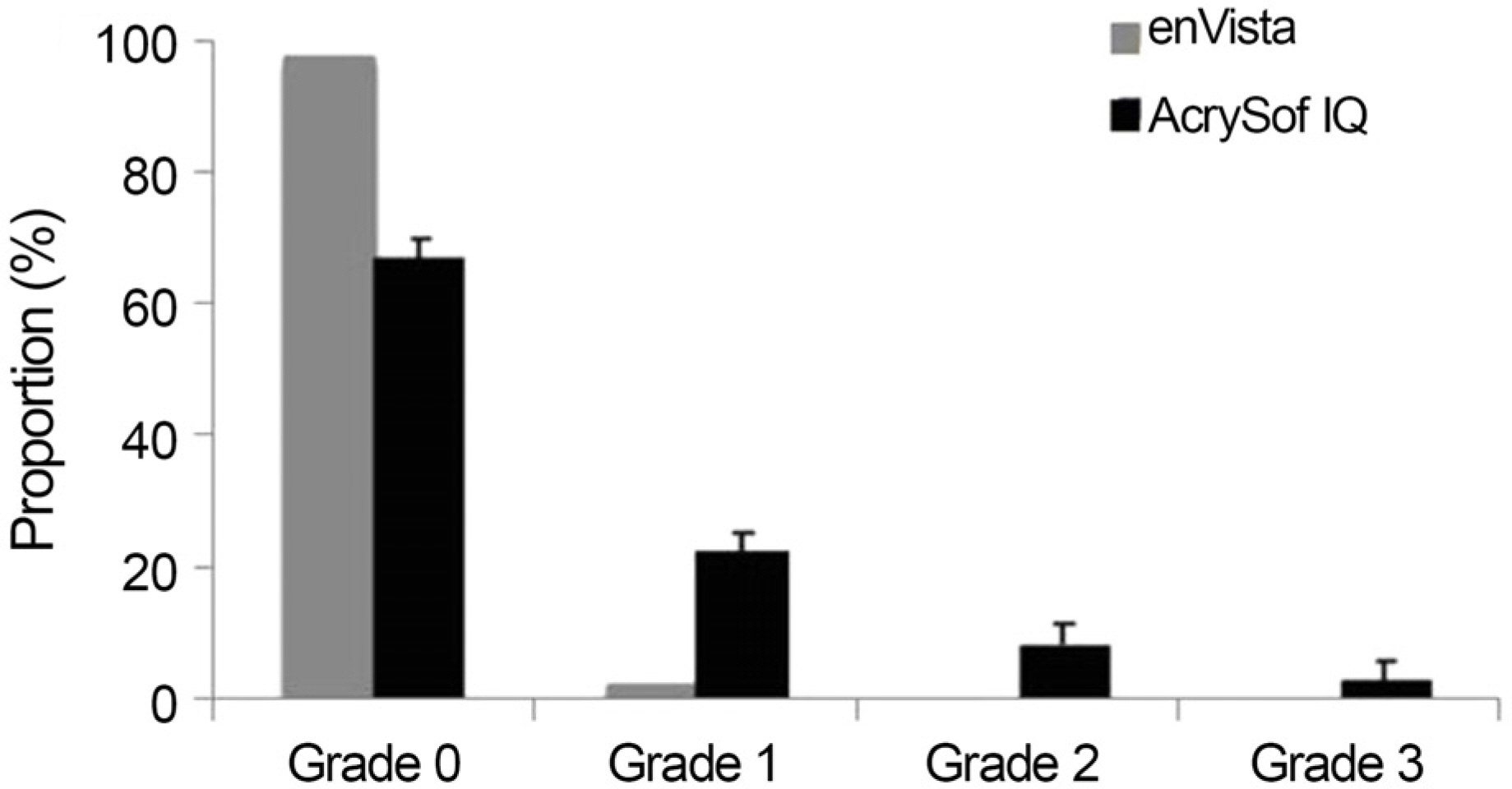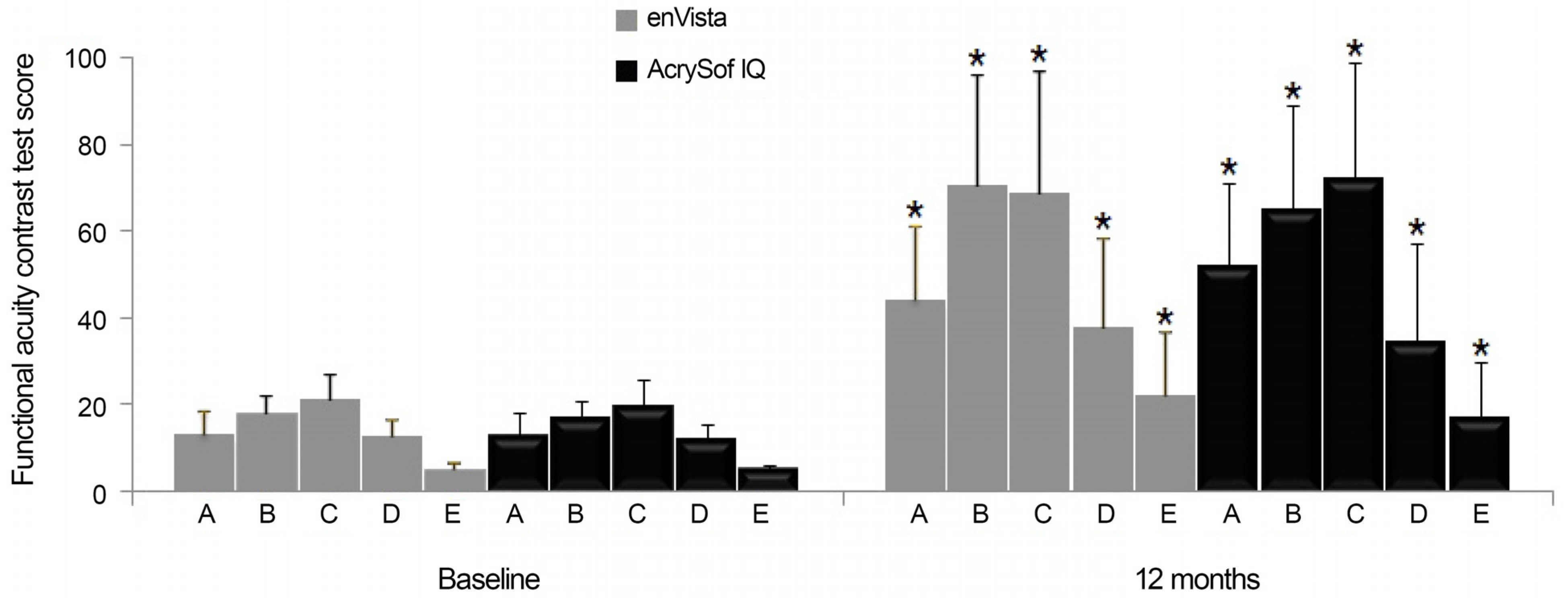J Korean Ophthalmol Soc.
2016 Feb;57(2):221-227. 10.3341/jkos.2016.57.2.221.
Comparison of Clinical Long-Term Outcomes with Two Types of One-Piece Aspheric Intraocular Lenses after Cataract Surgery
- Affiliations
-
- 1Department of Ophthalmology, Chonnam National University Medical School, Gwangju, Korea. kcyoon@jnu.ac.kr
- KMID: 2213662
- DOI: http://doi.org/10.3341/jkos.2016.57.2.221
Abstract
- PURPOSE
To compare the clinical outcomes of glistening-free intraocular lens (IOL) and conventional 1-piece aspheric IOL in implanted in-the-bag.
METHODS
After phacoemulsification performed by a single surgeon, 2 different IOLs were implanted: enVista MX60 (glistening-free 1-piece aspheric IOL) in 38 eyes (group A) and AcrySof IQ (conventional 1-piece aspheric IOL) in 46 eyes (group B). Glare symptom score (0-5) obtained by questionnaires, best corrected visual acuity (BCVA), Functional Acuity Contrast Test (FACT), posterior capsular opacity (PCO), glistening formation and spherical equivalent error were compared and analyzed preoperatively and 6 months and 12 months postoperatively.
RESULTS
A statistically significant improvement of BCVA and contrast sensitivity postoperatively was observed in all groups. There was statistically significant increase of glistening in group B compared with group A. However, there was no significant difference of FACT scores of spatial frequency in A, B, C, D and E columns and glare symptom score (0-10) obtained by questionnaires 12 months after surgery. Spherical equivalent errors were -0.38 +/- 0.27 D and -0.36 +/- 0.28 D for groups A and B, respectively. PCO occurred in 2 eyes in group A and 4 eyes in group B.
CONCLUSIONS
EnVista MX60 IOL showed less glistening formation than AcrySof IQ IOL, however, there was no significant difference in terms of vision quality such as BCVA, FACT and glare symptom score at 12 months postoperatively.
Figure
Cited by 1 articles
-
Intraindividual Comparison of Visual Outcomes between Blue Light-filtering and Ultraviolet Light-filtering Intraocular Lens
Geun Young Lee, Im Gyu Kim, Sung Yu, Gwang Ja Lee, Kyoo Won Lee, Young Jeung Park
J Korean Ophthalmol Soc. 2017;58(1):34-42. doi: 10.3341/jkos.2017.58.1.34.
Reference
-
1). Dhaliwal DK, Mamalis N, Olson RJ, et al. Visual significance of glistenings seen in the AcrySof intraocular lens. J Cataract Refract Surg. 1996; 22:452–7.
Article2). Davison JA. Clinical performance of Alcon SA30AL and SA60AT single-piece acrylic intraocular lenses. J Cataract Refract Surg. 2002; 28:1112–23.
Article3). Waite A, Faulkner N, Olson RJ. Glistenings in the single-piece, hydrophobic, acrylic intraocular lenses. Am J Ophthalmol. 2007; 144:143–4.
Article4). Nishihara H, Kageyama T, Ohnishi T, et al. Glistenings in lathe-cut acrylic intraocular lens. Ganka Shujutsu. 2000; 13:227–30.5). Omar O, Pirayesh A, Mamalis N, Olson RJ. In vitro analysis of AcrySof intraocular lens glistenings in AcryPak and Wagon Wheel packaging. J Cataract Refract Surg. 1998; 24:107–13.
Article6). Ayaki M, Nishihara H, Yaguchi S, Koide R. Effect of ophthalmic solution components on acrylic intraocular lenses. J Cataract Refract Surg. 2007; 33:122–6.
Article7). Oshika T, Shiokawa Y, Amano S, Mitomo K. Influence of glistenings on the optical quality of acrylic foldable intraocular lens. Br J Ophthalmol. 2001; 85:1034–7.
Article8). Choi YJ, Han KE, Ahn JM, et al. Comparisons of clinical results after implantation of three aspheric intraocular lenses. J Korean Ophthalmol Soc. 2013; 54:251–6.
Article9). Lee K, Yoon MH, Seo KY, et al. Comparisons of clinical results after implantation of three aspheric intraocular lenses. J Korean Ophthalmol Soc. 2013; 54:1213–8.
Article10). Han J, Han KE, Ahn JM, et al. Influence of pupil size on visual acuity after implantation of the TECNIS 1-piece intraocular lens. J Korean Ophthalmol Soc. 2012; 53:1615–20.
Article11). Kwak AY, Choi M, Seo KY, Ahn JM. Comparison of optical quality between two intraocular lenses using double-pass based optical quality analysis system. J Korean Ophthalmol Soc. 2013; 54:1818–23.
Article12). Parede TR, Torricelli AA, Mukai A, et al. Quality of vision in refractive and cataract surgery, indirect measurers: review article. Arq Bras Oftalmol. 2013; 76:386–90.
Article13). Cheon MH, Lee JE, Kim JH, et al. One-year outcome of monocular implant of aspheric multifocal IOL. J Korean Ophthalmol Soc. 2010; 51:822–8.
Article14). Wejde G, Kugelberg M, Zetterström C. Posterior capsule opacification: comparison of 3 intraocular lenses of different materials and design. J Cataract Refract Surg. 2003; 29:1556–9.
Article15). Ginsburg AP, Evans DW, Sekule R, Harp SA. Contrast sensitivity predicts pilots' performance in aircraft simulators. Am J Optom Physiol Opt. 1982; 59:105–9.
Article16). Pesudovs K, Hazel CA, Doran RM, Elliott DB. The usefulness of Vistech and FACT contrast sensitivity charts for cataract and refractive surgery outcomes research. Br J Ophthalmol. 2004; 88:11–6.
Article17). Holladay JT, Piers PA, Koranyi G, et al. A new intraocular lens design to reduce spherical aberration of pseudophakic eyes. J Refract Surg. 2002; 18:683–91.
Article18). Bae HW, Kim EK, Kim TI. Spherical aberration, contrast sensitivity and depth of focus with three aspherical intraocular lenses. J Korean Ophthalmol Soc. 2009; 50:1639–44.
Article19). Son SW, Seo JW, Shin SJ, Chung SK. Comparison of the stability between three-piece and single-piece aspheric intraocular lenses. J Korean Ophthalmol Soc. 2010; 51:1584–9.
Article20). Miyata A, Yaguchi S. Equilibrium water content and glistenings in acrylic intraocular lenses. J Cataract Refract Surg. 2004; 30:1768–72.
Article21). Apple DJ, Mamalis N, Olson RJ, Kincaid MC. Intraocular Lenses: evolution, designs, complications, and pathology. Baltimore: Williams & Wilkins;1989. p. 11–41.22). Saylor DM, Coleman Richardson D, Dair BJ, Pollack SK. Osmotic cavitation of elastomeric intraocular lenses. Acta Biomater. 2010; 6:1090–8.
Article23). Gregori NZ, Spencer TS, Mamalis N, Olson RJ. In vitro comparison of glistening formation among hydrophobic acrylic intraocular lenses(1). J Cataract Refract Surg. 2002; 28:1262–8.24). Packer M, Fry L, Lavery KT, et al. Safety and effectiveness of a glistening-free single-piece hydrophobic acrylic intraocular lens (enVista). Clin Ophthalmol. 2013; 7:1905–12.
Article25). Heiner P, Ligabue E, Fan A, Lam D. Safety and effectiveness of a single-piece hydrophobic acrylic intraocular lens (enVista[R]) - results of a European and Asian-Pacific study. Clin Ophthalmol. 2014; 8:629–35.26). Leydolt C, Schriefl S, Stifter E, et al. Posterior capsule opacification with the iMics1 NY-60 and AcrySof SN60WF 1-piece hydrophobic acrylic intraocular lenses: 3-year results of a randomized trial. Am J Ophthalmol. 2013; 156:375–81. e2.
Article27). Colin J, Orignac I, Touboul D. Glistenings in a large series of hydrophobic acrylic intraocular lenses. J Cataract Refract Surg. 2009; 35:2121–6.
Article28). Hayashi K, Hirata A, Yoshida M, et al. Long-term effect of surface light scattering and glistenings of intraocular lenses on visual function. Am J Ophthalmol. 2012; 154:240–51. e2.
Article29). Christiansen G, Durcan FJ, Olson RJ, Christiansen K. Glistenings in the AcrySof intraocular lens: pilot study. J Cataract Refract Surg. 2001; 27:728–33.
Article30). Gunenc U, Oner FH, Tongal S, Ferliel M. Effects on visual function of glistenings and folding marks in AcrySof intraocular lenses. J Cataract Refract Surg. 2001; 27:1611–4.
Article31). Dogru M, Tetsumoto K, Tagami Y, et al. Optical and atomic force microscopy of an explanted AcrySof intraocular lens with glistenings. J Cataract Refract Surg. 2000; 26:571–5.
Article
- Full Text Links
- Actions
-
Cited
- CITED
-
- Close
- Share
- Similar articles
-
- Comparison of Anterior Chamber Parameter and Refractive Change between Three-Piece and Single-Piece Aspheric Intraocular Lenses
- Comparative Study of Clinical Outcomes between 2 Types of 3-Piece Aspheric Intraocular Lenses
- Comparison of the Stability Between Three-piece and Single-piece Aspheric Intraocular Lenses
- Comparing Clinical Results after Intraocular Lens Implantation Surgery Using Three Other Aspheric Lenses
- Clinical Outcomes of Aspheric 1-Piece (Tecnis(R) ZCB00) and 3-Piece (Tecnis(R) ZA9003) Aspheric Intraocular Lens for 12 Months






